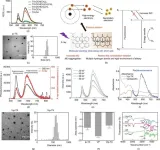(Press-News.org) As Earth continues to warm, sea levels have risen at an accelerating rate – from 1.4 millimeters a year to 3.6 millimeters a year between 2000 and 2015. Flooding will inevitably worsen, particularly in low-lying coastal regions, where more than a billion people are estimated to live. Solutions are needed to protect homes, property and groundwater from flooding and the intrusion of saltwater.
Seawalls and similar infrastructure are obvious options to protect against flooding. In fact, cities such as New York and San Franciso have already thrashed out potential plans with the Army Corps of Engineers that will heavily rely on seawalls. But these plans come with a hefty price tag, estimated at tens of billions of dollars.
Further complicating planning, a new paper has found that seawalls and other shoreline barriers, which extend below the surface, might actually lead to more groundwater flooding, result in less protection against saltwater intrusion into groundwater, and end up with a lot of water to deal with inside of the area that seawalls were supposed to protect.
The paper, “Shoreline barriers may amplify coast groundwater hazards with sea-level rise,” was published in Scientific Reports, which is part of the Nature portfolio. The paper was written by Xin Su, a research assistant professor at the University of Memphis; Kevin Befus, an assistant professor at the U of A; and Michelle Hummel, an assistant professor at the University of Texas at Arlington. Su was previously a post-doctoral researcher working with Befus in the U of A’s Geosciences Department before assuming her current position.
The paper provides an overview of how sea-level rise causes salty groundwater to move inland and replace the fresh groundwater that was there, a process known as saltwater intrusion. At the same time, the fresh and salty groundwater both rise toward the ground surface because of the higher sea level. This can cause flooding from below, also known as groundwater emergence.
Walls can be built underground to reduce saltwater intrusion, but this can lead to groundwater getting stuck behind the walls, which act like an underground dam. This can cause even more groundwater to move up to the ground surface, which can in turn infiltrate sewer systems and water mains.
“These barriers can backfire if they don't take into account the potential for inland flooding caused by rising groundwater levels,” Su explained. “Excessive groundwater could potentially reduce sewer capacity, increase the risk of corrosion and contaminate the drinking water supply by weakening the pipes.”
The researchers noted that studies prior to this one did not include the groundwater flooding effects, which led those studies to anticipate more benefits from underground walls than this latest paper now suggests.
“The standard plan for protecting against flooding is to build seawalls,” Befus added. “Our simulations show that just building seawalls will lead to water seeping in under the wall from the ocean as well as filling up from the landward side. Ultimately, this means if we want to build seawalls, we need to be ready to pump a lot of water for as long as we want to keep that area dry – this is what the Dutch have had to do for centuries with first windmills and now large pumps.”
Su concluded: “We found that building these protection barriers without accounting for potential inland flooding risks from groundwater can eventually worsen the very issues they aim to solve.”
She added that “these risks highlight the need for careful planning when building barriers, especially in densely populated coastal communities. By addressing these potential issues, coastal communities can be better protected from rising sea levels.”
When building flood-related or underground walls, there appears to be no perfect solution that prevents saltwater intrusion or groundwater flooding. As such, the researchers recommend that any underground barriers have additional plans to deal with the extra water that would pond up inland of the barrier, such as using pumps or French drains, which utilize perforated pipes embedded in gravel or loose rock that direct water away from foundations.
City planners in New York, San Francisco and coastal cities globally would do well to take heed of this as they develop plans to combat rising sea levels.
END
Barriers designed to prevent saltwater intrusion may worsen inland flooding
A new paper finds that subsurface barriers will likely lead to more groundwater flooding and result in less protection against saltwater intrusion into groundwater.
2024-07-31
ELSE PRESS RELEASES FROM THIS DATE:
Vaping and smoking together increases lung cancer risk fourfold
2024-07-31
COLUMBUS, Ohio – People who both vape and smoke are four times more likely to develop lung cancer than people who just smoke, according to new study published by The Ohio State University Comprehensive Cancer Center – Arthur G. James Cancer Hospital and Richard J. Solove Research Institute (OSUCCC – James) and College of Public Health. These findings were consistent across gender and race.
This is the first study to provide evidence that smoking in combination with vaping increases the risk for cancer compared to smoking alone. Researchers ...
Scientists discover unexpected behavior in dimers of CO₂ molecules after ionization
2024-07-31
A team of international scientists has unveiled a surprising discovery in molecular physics, revealing unexpected symmetry-breaking dynamics in ionized carbon dioxide dimers. Published in Nature Communications, the study provides new insights into the structural changes that occur when these molecular clusters are exposed to extreme ultraviolet (EUV) radiation.
An international team of scientists, led by Profs. Daniel Strasser and Roi Baer from The Hebrew University of Jerusalem, has made an important discovery in molecular physics, revealing unexpected symmetry-breaking dynamics in ionized carbon dioxide dimers. Published in Nature Communications, ...
Cracking the carb code: Researchers create new glycemic index database to improve dietary awareness
2024-07-31
Karen Della Corte, BYU nutrition and dietetics professor, recently authored a new study, published in The American Journal of Clinical Nutrition, that developed a national glycemic index (GI) and glycemic load (GL) database to offer insights into the evolving quality of carbohydrates consumed in the United States, something that hadn’t been done previously.
The GI is a scale used by public health researchers to categorize the quality of the carbohydrates. High-GI foods like white flour and sugar cereals cause a “sugar rush” that can negatively impact metabolic health. ...
Military health research reveals potential pathway to reducing youth suicide
2024-07-31
Military-connected youth that show elevated risk for suicidal ideation and suicide plans exhibit lower rates of gun-carrying, according to new research from emergency medicine faculty at the University of Colorado School of Medicine.
The analysis, published in JAMA Network Open July 31 by members of the CU Center for Combat Medicine and Battlefield (COMBAT) Researchand Firearm Injury Prevention Initiative (FIPI), offers promising insight for potentially reducing gun-carrying among youths with recent suicidal ideation or plans. Researchers are also interested in how relevant strategies in military communities ...
Cannabinoid CBG reduces anxiety and stress in first human clinical trial
2024-07-31
PULLMAN, Wash. — A lesser-known cannabinoid that is gaining in popularity Cannabigerol (CBG) effectively reduced anxiety in a clinical trial without the intoxication typically associated with whole plant cannabis. It may even have some memory enhancing effects, according to a new study in Scientific Reports.
For the study, Carrie Cuttler, an associate professor of psychology at Washington State University, and colleagues conducted the first human clinical trial investigating the acute effects of CBG on anxiety, stress and mood.
The research revealed that 20 mg of hemp-derived CBG significantly reduced feelings of anxiety at 20, ...
University hospitals nationally recognized for high-quality stroke care
2024-07-31
CLEVELAND — University Hospitals (UH) has received numerous American Heart Association Get With The Guidelines® - Stroke quality achievement awards for ensuring stroke patients receive the most appropriate treatment according to nationally recognized, research-based guidelines, ultimately leading to more lives saved and reduced disability.
Stroke is the No. 5 cause of death and a leading cause of disability in the U.S. A stroke occurs when a blood vessel that carries oxygen and nutrients to the brain is either blocked by a clot or bursts. When that happens, part of the brain cannot get the blood and oxygen it needs, so ...
Humans are born to run
2024-07-31
The 2024 Summer Olympics are in full swing. One of the marquee events is of course the marathon, a grueling test of fitness and athleticism.
When it comes to endurance running, humans are among the very top mammals in their athletic prowess. While we may not be the best sprinters in the animal kingdom, we can run steadily for long distances, even in hot weather. Our locomotor muscles are dominated by slow-twitch, fatigue-resistant fibers and our unique ability to sweat allows our bodies to effectively dissipate heat.
Humans are so good at endurance running, it seems we were born to do it. But why?
A theory of endurance
In ...
Medicaid enrollees struggle to find psychiatric care
2024-07-31
Many people enrolled in Medicaid who require psychiatric care have difficulty accessing clinicians in a timely manner despite the higher need in this population, according to a study by researchers at Weill Cornell Medicine.
The results published July 31 in JAMA found that few psychiatrists and other mental health professionals who are listed as accepting new patients enrolled in Medicaid are actually reachable and have appointments available. In cases when appointments could be made, wait times sometimes extended up to six months. The research was conducted by first author Dr. Diksha Brahmbhatt (M.D. ’24), who is now a resident physician at Brigham and Women’s ...
Smithsonian scientists devise method to secure Earth’s biodiversity on the moon
2024-07-31
New research led by scientists at the Smithsonian proposes a plan to safeguard Earth’s imperiled biodiversity by cryogenically preserving biological material on the moon. The moon’s permanently shadowed craters are cold enough for cryogenic preservation without the need for electricity or liquid nitrogen, according to the researchers.
The paper, published today in BioScience and written in collaboration with researchers from the Smithsonian’s National Zoo and Conservation ...
Revolutionary x-ray-sensitizers could transform cancer treatment with low-dose radiation therapy
2024-07-31
Researchers at Xiamen University have made a significant advancement in cancer treatment by developing a novel class of X-ray-sensitizers (XSs) that could revolutionize radiotherapy. Published in Engineering, their groundbreaking study highlights how specific organic pharmaceutical drug intermediates, derived from thioxanthone (TX), can be activated by low-dose X-rays to efficiently generate singlet oxygen for targeted cancer therapy.
Traditional radiotherapy, a cornerstone in cancer treatment, often involves high doses of radiation (typically over 50 Gy), which can lead ...
LAST 30 PRESS RELEASES:
Making lighter work of calculating fluid and heat flow
Normalizing blood sugar can halve heart attack risk
Lowering blood sugar cuts heart attack risk in people with prediabetes
Study links genetic variants to risk of blinding eye disease in premature infants
Non-opioid ‘pain sponge’ therapy halts cartilage degeneration and relieves chronic pain
AI can pick up cultural values by mimicking how kids learn
China’s ecological redlines offer fast track to 30 x 30 global conservation goal
Invisible indoor threats: emerging household contaminants and their growing risks to human health
Adding antibody treatment to chemo boosts outcomes for children with rare cancer
Germline pathogenic variants among women without a history of breast cancer
Tanning beds triple melanoma risk, potentially causing broad DNA damage
Unique bond identified as key to viral infection speed
Indoor tanning makes youthful skin much older on a genetic level
Mouse model sheds new light on the causes and potential solutions to human GI problems linked to muscular dystrophy
The Journal of Nuclear Medicine ahead-of-print tip sheet: December 12, 2025
Smarter tools for peering into the microscopic world
Applications open for funding to conduct research in the Kinsey Institute archives
Global measure underestimates the severity of food insecurity
Child survivors of critical illness are missing out on timely follow up care
Risk-based vs annual breast cancer screening / the WISDOM randomized clinical trial
University of Toronto launches Electric Vehicle Innovation Ontario to accelerate advanced EV technologies and build Canada’s innovation advantage
Early relapse predicts poor outcomes in aggressive blood cancer
American College of Lifestyle Medicine applauds two CMS models aligned with lifestyle medicine practice and reimbursement
Clinical trial finds cannabis use not a barrier to quitting nicotine vaping
Supplemental nutrition assistance program policies and food insecurity
Switching immune cells to “night mode” could limit damage after a heart attack, study suggests
URI-based Global RIghts Project report spotlights continued troubling trends in worldwide inhumane treatment
Neutrophils are less aggressive at night, explaining why nighttime heart attacks cause less damage than daytime events
Menopausal hormone therapy may not pose breast cancer risk for women with BRCA mutations
Mobile health tool may improve quality of life for adolescent and young adult breast cancer survivors
[Press-News.org] Barriers designed to prevent saltwater intrusion may worsen inland floodingA new paper finds that subsurface barriers will likely lead to more groundwater flooding and result in less protection against saltwater intrusion into groundwater.



